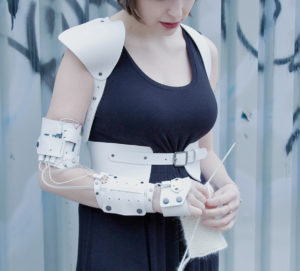 The first knitted socks date to Egypt in the 1100s. (They must not have fit or they would have worn out instead of surviving all those centuries.) And hand knitting is still popular today, even though the cost of yarn frequently means it is much cheaper to buy ready-made; but, you know, arts and crafts and all that. Knitting has longevity. It has not yet been ousted by technology, even industrial knitting machines.
The first knitted socks date to Egypt in the 1100s. (They must not have fit or they would have worn out instead of surviving all those centuries.) And hand knitting is still popular today, even though the cost of yarn frequently means it is much cheaper to buy ready-made; but, you know, arts and crafts and all that. Knitting has longevity. It has not yet been ousted by technology, even industrial knitting machines.
However, a graduate student named Theresa Flour Lamb has taken seriously rumors that technology is set to replace all creative human activities with mechanical sameness. So seriously, that her Master’s thesis is a wearable device that takes the motion of knitting and turns it into music. It works with crocheting, too, and presumably with other rhythmic motion, like rocking. (There already exists a rocking chair that knits while you rock, but we’re not going there.)
Lamb calls her device Cyberknitics, a phrase we wish we had come up with first. The device, in its first iteration, looks like a back brace combined with an open arm cast. Lamb calls it a “harness-like vestment,” and it is actually several pieces connected by silicon stranded wire. It includes a gyro sensor and accelerometer on the user’s hand; an Arduino running Teensy 3.2 on the forearm; and the audio adaptor board on the upper arm. The music can be routed through speakers or headphones.
“As someone who knits, I have become increasingly interested in how to capture and convey the natural rhythm of the craft,” said Lamb. “The music is meant to inspire a stronger connection between the knitter and their process, and to invite the audience to engage with the spiritual practice of creating something from nothing.”